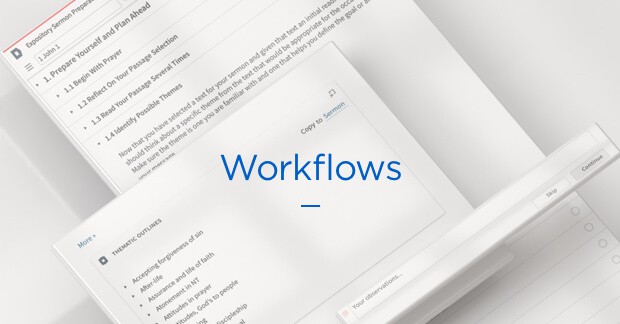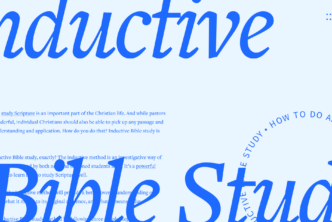Logos can perform many technical Bible study tasks, like morphology queries and syntax searches. That’s why a lot of pastors and scholars use it.
But if you don’t know what morphology is, is Logos beyond you?
Not at all.
There are dozens of reasons Logos is ideal for any Christian, but with the release of Logos 8 comes one reason that ties them all together: Workflows.
What are Workflows?
Workflows is a new Logos feature that takes you step by step through common approaches to Bible study. And not only that, it tells you what resources to consult as you move through the process. As you go through a workflow, Logos stores your thoughts, questions, and responses in a notebook that you can go back and access at any time.
So whether you’ve never cracked open a Bible or have been reading it for years, you can find a guide to take you deeper than where you are now.
Let me show you with a few examples.
Example 1: Devotional workflow
The simplest of all the Workflows, the Devotional workflow, provides a template for a more meditative approach to Scripture.
It’ll encourage you to choose a Bible reading plan and then use this template to work through it, helping you capture your thoughts, life application, and prayers.
Along the way, each step comes with instructions to help you stay on track, and almost every step has a space for writing out your thoughts and observations.
For example, during the third step—the meatiest portion of the Devotional workflow—you are prompted to jot down your thoughts as well as your questions on a passage.
Benefits of this workflow:
- Provides a simple structure to guide your time in God’s Word
- Saves your thoughts as notes, functioning as a sort of Bible/prayer journal
- Helps you make prayer a consistent and vital part of Bible study
Example 2: Basic Bible Study
A step deeper is the Basic Bible Study workflow.
Here you begin interacting with other translations, consulting other parts of Scripture to help you better understand your passage, and read what Bible scholars have to say about it.
This is where the power of Logos really comes in to support someone unfamiliar with Logos or in-depth Bible study.
For example, in step 2, “Read the Passage in Other Translations,” the workflow explains why it’s valuable to compare Bible translations when studying the Bible. When you’re ready to dive in, simply click the “Compare Bible versions” link and Logos automatically opens five translations for you, and you can change those translations to your liking.
The same sort of thing happens in the other steps, too. A table of cross-references is provided for you in step 4, and step 8 points you to commentaries in your library with information on your list.
With Workflows, you don’t go looking for anything—it’s all provided for you.
Benefits of this workflow:
- Trains you in basic Bible study tasks
- Provides quick access to tools and resources in Logos to help you study
- Grows your knowledge of theology as you study the Bible
Example 3: Inductive Bible Study
Lastly, the Inductive Bible Study workflow takes you about as deep into Scripture as you can go without knowing Greek or Hebrew.
Even though there are only 3 main steps, there are 18 substeps, making this a more intensive process.
But still, you could jump right into this one without ever touching the other two I’ve mentioned.
That’s because Workflows doesn’t drop you into a passage and say, “Go.” It leads you into that passage and tells you what to look for.
For example, look at step 2.1, “Examine the Context of the Book.”
If you look in the step explanation, you’ll see two links leading you to Logos resources that give you an in-depth look at the context, the Factbook tool, and the Faithlife Study Bible. You can use the Factbook to look up people, places, and more that appear in your text. The Faithlife Study Bible provides extended introductions to each book of the Bible, as well as verse-by-verse commentary.
Or consider step 2.6, “Research Important Words.”
You might not know reading your passage what words are important, but Logos does. The Important Words tool displays a ranked list of words based on the frequency they’re discussed in commentaries on your passage.
As you browse the list, you’ll see the English translation on the right, the transliteration (how to pronounce the Greek word) in the middle, and the Greek word on the left. So you can actually start learning Greek if you want to! But you don’t have to—Logos allows you to learn a lot about a specific word without knowing any Hebrew or Greek.
And with a simple click of any of those words, you launch a word study to learn more about how it is used in the Bible.
Benefits of this workflow:
- Guides you in exploring the deeper parts of Bible study
- Prepares you exceedingly well to teach a passage to others
- Introduces you to more advanced Logos tools, including those used for original language study, with the original languages of the Bible
With all of these workflows, the big thing that makes them suitable for laypeople is that you don’t have to know how to study the Bible to use them.
Rather, you will learn how to study the Bible by using them.
And that’s just one reason why Logos is important for everyone, too.
***
Get all these workflows in Logos 8 Starter, the most affordable version of Logos 8.





